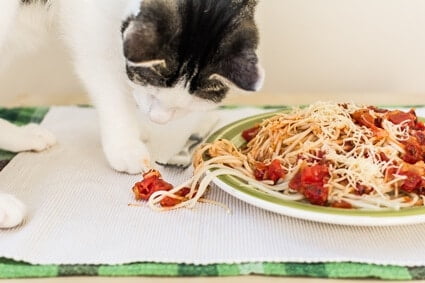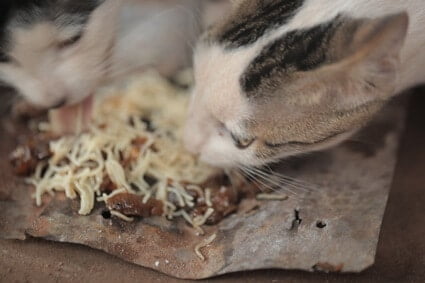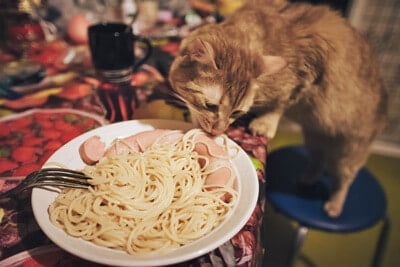Pasta is a staple food for many households. It’s versatile, easy to prepare, packed with carbs, and provides a healthy meal. Pasta and the many different sauces may be OK for humans to eat, but is pasta good for cats?
Pasta is not bad for cats, but it is considered empty calories in a cat’s diet. Essentially, pasta is junk food for cats. This is because pasta is full of complex carbohydrates. Cats have evolved to process protein into energy in place of carbohydrates. Thus, cats do not need carbohydrate-rich food like pasta and cannot process it efficiently. Feeding cats pasta can be safely done, but too much will result in weight gain.
Feeding pasta to a cat should only be done with plain, cooked pasta. Uncooked pasta poses choking and impaction issues. Pasta sauces contain many food items that are bad or toxic to cats. Dairy-based sauces can cause gastrointestinal issues because cats are lactose intolerant. Tomato-based sauces can induce toxicosis, especially if it contains onions or garlic.
Is Pasta Safe for Cats To Eat?
On its own, cooked pasta is OK for a cat to eat. It does not have any toxic properties and is not classed as toxic by animal organizations. Pasta is generally a mixture of eggs, flour, water, and salt. Cats do not seem to show any adverse reactions to this mixture once it’s cooked.
It is safe for a cat to nibble on a few small pieces of cooked pasta. Excluding allergies, it is rare that the odd treat will impact its health.
All of this is good news for those of us with cats that enjoy sneaking onto the kitchen counter. However, just because pasta is safe for a cat to eat doesn’t mean it is good for it to eat. Pasta offers almost no nutritional value to cats. It’s full of carbohydrates, which are good for us, but not so much for cats.
In small amounts and infrequent occasions, pasta is not unhealthy for cats to eat. On the other hand, frequent or larger meals will make cats sick.
Is Whole Grain Pasta Bad for Cats?
Whole grain pasta isn’t healthy for cats. Regular pasta is made with grains that have been processed to strip away the bran and germ. Humans benefit from eating the whole grain, as there are more nutrients in a whole grain than a stripped grain. The same cannot be said for cats.
As noted in Veterinary Sciences, cats are obligate carnivores that have evolved to thrive off of a meat diet. The digestive system of a cat is designed to break down the meat and convert that protein and fat into energy. The physiology of cats has also developed to thrive off of low-carbohydrate prey. What this means is a cat cannot properly digest or extract nutrients from grains efficiently. Whole grains make this even harder.
Grains are finely milled for making pasta. Small amounts of whole-grain pasta on occasion are safe for cats to eat once it has been cooked.
Is Chocolate Pasta Bad For Cats?
Yes, chocolate pasta is a real thing, and yes, chocolate pasta is bad for cats. It can actually be quite dangerous.
Chocolate is potentially lethal to cats. As stated in Companion Animals, chocolate contains theobromine. This is a methylxanthine. In cats, this stimulates the central nervous system with respiratory and cardiac hyperactivity. This can cause:
- Hyperactivity
- Tremors
- Hypertension
- Hyperthermia
- Vomiting
- Diarrhea
Even a small amount of chocolate pasta can really upset your cat’s digestive system. Or cause any one or all of the above issues. Kittens and senior cats are more sensitive to such side effects as well. An emergency trip to the vet will result from chocolate toxicosis. Full recoveries are common in animals that were healthy prior to ingestion. In bad cases, chocolate toxicosis can result in death.
Is Raw Pasta Bad for Cats?
Dental treats and kibble are good for maintaining healthy teeth. It can be tempting to consider dry pasta (also called raw pasta) a dental treat. However, dry pasta is not good for cats. It is actually quite harmful.
Not only is raw pasta far more difficult for a cat to digest, but it can also cause internal impactions and stomach issues. It can also damage teeth, choke your cat, and damage the inside of its mouth and throat. Uncooked pasta shatters and breaks into shards. These shards can be quite sharp.
Uncooked flour also contains lectins and phytate. These are anti-nutrients that can inflame, damage, and disrupt internal systems. The same goes for fresh raw pasta, with the addition of raw eggs and salmonella to be concerned about.
It is not safe to feed raw or uncooked pasta to a cat. If your cat has eaten either raw or fresh pasta, keep a close eye on it for any issues and keep your vet’s contact information close.

Is Pasta Sauce Bad for Cats?
Pasta sauces introduce a whole new layer of potential problems. Most pasta sauces are either dairy-based or tomato-based, and neither of these foods is good for your cat. We’ve looked at the most popular pasta sauces below to explain how they can potentially be toxic.
This section will illustrate how very easy it is for a pasta sauce to be unhealthy for a cat. If you don’t know the exact ingredients are in a sauce, the risk for accidental poisoning increases. Bottled sauces, also called pre-made and packaged sauces might also contain foods and preservatives toxic to cats.
On a whole, it is best to only feed cats unseasoned, cooked pasta without sauce. Sauces introduce too many risks.
Cheese Sauce
Despite cartoons teaching you as a kid that cats love drinking saucers of milk, most cats can’t actually eat dairy. Cheese sauce, which is the basis of any classic mac n’ cheese or carbonara, is made primarily of dairy. Cooking the dairy makes no difference to how it affects the lactose intolerant.
Almost all cats are lactose intolerant. Dairy will often cause gastrointestinal issues. A tiny amount of cheese sauce, that does not have additional seasonings, won’t hurt your cat. But, it won’t be good for them either. Nor will it offer any nutritional value.
Some cheese sauce recipes also call for seasonings. This could include garlic powder and onion powder. Garlic and onion, in any form, is toxic to cats. Even a small amount can induce toxicosis, which can result in permanent organ damage and death.
Bolognese Sauce
Bolognese sauces require a number of ingredients, some of which are unhealthy or toxic to cats. Onion and garlic will induce toxicosis. Sauces that call for wine, white or red, can also be toxic. Wine is made from grapes, which are highly toxic to cats and can cause kidney failure and death.
It is okay to offer a small amount of cooked beef to your cat before any seasonings or wine is added. Once seasonings, wine, and vegetables have been added to the sauce, however, it becomes dangerous to cats.
Pesto Sauce
Pesto is one of the simpler pasta sauces, and most of the ingredients are safe for cats. Pine nuts, olive oil, and basil are all non-toxic to cats. Pine nuts are high in fat, however. Cheese, in anything other than a small quantity, can cause diarrhea. Pesto has garlic, which makes it unsafe.
Is Pasta Good for Cats?
So, cats can eat pasta. But, is it actually good for them? The short answer is no. The long answer involves complex carbohydrates.
Pasta is full of complex carbohydrates called starches. Certain animals have digestive systems that break these starches down in order to make glucose, which the body uses as fuel. Cats are not one of these animals. Cats have evolved specifically to, as said in the Journal of the American Veterinary Medical Association, survive on eating prey high in protein and with minimal amounts of carbohydrates.
This publication also says that cats have metabolically adapted to convert protein into energy. A cat literally does not need carbohydrates to survive. A cat can still benefit from them, but there are better sources of carbohydrates far easier for it to digest.
On the whole, pasta is not good for cats in any capacity, as it doesn’t offer any nutritional value. Pasta is basically empty calories.
Cats have evolved to source energy from protein, meaning they don’t need carbohydrates. This does not mean that they can’t benefit from them.
Risks of Feeding Cats Pasta
Pasta is not bad for cats. Nor is it good for them. Still, if you decide to offer your cat a few morsels of cooked pasta there are issues to watch for.
Allergies
Although not overly common, gluten allergies can be a problem for cats. Even a small amount of pasta can cause an allergic reaction. Your cat may also have a lesser intolerance, such as gluten intolerance or gluten sensitivity. If you choose to feed your cat pasta, keep an eye out for the following symptoms:
- Weight loss
- Asthma
- Vomiting
- Constant scratching
- Dry, flaking, or irritated skin
- Diarrhea
If you notice any of these symptoms stop feeding your cat pasta immediately and contact a vet.

Obesity
Not that long ago the trending idea for weight loss was to severely cut back on your carbohydrate intake. Counting carbs, as it were. The same approach should be applied when feeding a cat pasta.
Cats have evolved to preserve energy efficiently. Feeding a cat fatty or carbohydrate-heavy food can quickly cause it to gain weight. A study in the Journal of Feline Medicine and Surgery found that 39% of surveyed cat owners described their cats as overweight or obese.
Another article in the same journal notes that many other studies have estimated that up to 52% of household cats are overweight. This is largely attributed to cat owners not providing a proper diet, largely through ignorance.
Obesity does more than shorten its lifespan. It increases the risk for:
- Many types of cancer
- Heart disease
- Diabetes
- Hypertension
- Joint problems and arthritis
- Bladder stones
- Reduced heat tolerance
Pasta should only be fed to a cat as a small, rare treat. Including even slightly too much pasta in its diet can cause the cat to become overweight.
Digestive Issues
As we have said multiple times, cats cannot digest pasta as efficiently as we can. Feeding a cat too much pasta can cause it to have digestive issues.
How To Safely Feed Your Cat Pasta
Pasta shouldn’t be fed to a cat at all. It’s essentially junk food. However, if your vet has no objections to feeding your cat human food, then here is how to do so safely.
Ensure that the pasta is fully cooked, cooled, and free of any sauce or seasonings. Plucking a piece of pasta out of the colander after draining it and prior to adding any sauce is best. Remember, even a tiny amount of garlic or onion can harm your cat.
Offer a small piece of pasta to your cat. Keep a close eye on it for any adverse reactions once it has eaten. If there are any unpleasant reactions, do not feed pasta to your cat again. Contact your vet if symptoms last longer than 24 hours. Even if your cat seems to enjoy pasta, be careful to only offer it as a rare treat as it’s not really very good or healthy for cats.

